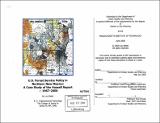| dc.contributor.advisor | Frank Levy. | en_US |
| dc.contributor.author | Baker, Lou, 1961- | en_US |
| dc.contributor.other | Massachusetts Institute of Technology. Dept. of Urban Studies and Planning. | en_US |
| dc.coverage.spatial | n-us-nm | en_US |
| dc.date.accessioned | 2011-06-20T15:49:52Z | |
| dc.date.available | 2011-06-20T15:49:52Z | |
| dc.date.copyright | 2000 | en_US |
| dc.date.issued | 2000 | en_US |
| dc.identifier.uri | http://hdl.handle.net/1721.1/64555 | |
| dc.description | Thesis (M.C.P.)--Massachusetts Institute of Technology, Dept. of Urban Studies and Planning, 2000. | en_US |
| dc.description | Includes bibliographical references (leaves 79-87). | en_US |
| dc.description.abstract | As a result of a court house raid in Tierra Amarilla, New Mexico, on June 5, 1967, these actions of local landgrant activists made national headlines and elicited highlevel interest in the land management practices of the United States Forest Service (USFS) in northern New Mexico.' These actions were instrumental in convening the Mexican-American Conference in El Paso, Texas in October 21, 1967. After attending the Mexican-American Conference, Southwest Regional Forester William D. Hurst initiated the study that resulted in the Hassell Report and lead to the subsequent creation of the Region 3 Policy. The Hassell Report was an assessment of the needs of the rural forest-dependent communities and as such, was not based on data and statistics but rather on qualitative community input. The subsequent policy implemented by Hurst on March 6, 1972, "...summarized and embodied some of the recommendations of the Hassell Report." Since its creation a century ago, the Forest Service has recognized the effects of forest management on local communities and has rhetorically embraced populist ideals to serve people and communities. But the strategies adopted by the Forest Service for meeting local community needs - Region 3 Policy - has failed to achieve this goal. This approach conflicts with ideals of and trends towards participation, posing a question of whether it remains viable in contemporary society. This managerial posture suggests why the USFS has experienced escalating conflict and eroding public confidence in its management of the national forests in northern New Mexico. One of the lessons of this case study is that attempting to address economic and cultural issues and actually implementing study recommendations into actions is two entirely different things. "A brilliant policy can easily flounder on the rocks of bureaucratic inertia, but such a policy, as in the case of northern New Mexico, may also acquire a life and constituency of its own and continue to influence the affairs of a region." | en_US |
| dc.description.statementofresponsibility | by Lou Baker. | en_US |
| dc.format.extent | 142 leaves | en_US |
| dc.language.iso | eng | en_US |
| dc.publisher | Massachusetts Institute of Technology | en_US |
| dc.rights | M.I.T. theses are protected by
copyright. They may be viewed from this source for any purpose, but
reproduction or distribution in any format is prohibited without written
permission. See provided URL for inquiries about permission. | en_US |
| dc.rights.uri | http://dspace.mit.edu/handle/1721.1/7582 | en_US |
| dc.subject | Urban Studies and Planning. | en_US |
| dc.title | U.S. Forest Service policy in northern New Mexico : a case study of the Hassell Report--1967-2000 | en_US |
| dc.title.alternative | US Forest Service policy in northern New Mexico | en_US |
| dc.title.alternative | United States Forest Service policy in northern New Mexico | en_US |
| dc.type | Thesis | en_US |
| dc.description.degree | M.C.P. | en_US |
| dc.contributor.department | Massachusetts Institute of Technology. Department of Urban Studies and Planning | |
| dc.identifier.oclc | 47912278 | en_US |
